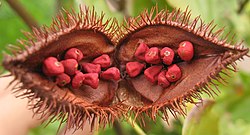胭脂树红
胭脂树红,又称为“婀娜多”(英语:Annatto),是从生长在热带和亚热带的红木(又称胭脂树)种子中提取的物质,可以作为食用色素将食物染成黄色、橘色,并添加特有的风味。

胭脂树红提取自包覆在红木种子外面的红色果皮。被用来为许多芝士(例如车打芝士、格洛斯特芝士)、加工干酪(例如美国芝士)或乳酱(例如人造黄油)染色。一些熏鱼、调味料和零食中也会加入胭脂树红。
红木原产自南美洲,传播到了亚洲的许多地区。在拉丁美洲和加勒比地区,经常需要用到胭脂树红来制作菜肴。中南美洲的一些土著居民用它来制作人体彩绘和口红。因此有时红木也被叫做“口红树”。成熟的红木果实呈褐色或红褐色,外面覆盖著坚硬的短毛,果实完全成熟后就会裂开,露出里面深红色的种子。虽然可以产生可食用的胭脂树红,但是果实本身并不可食用。[1]
历史
编辑胭脂树红被认为起源于巴西,当地人称“urucum”。[2]最初可能并不是用来做食物添加剂的,而是用在人体彩绘、治疗胃灼热和胃痛、驱逐昆虫以及抵挡魔鬼上。[3][4][5]在加勒比和南美洲原住民文化中有长期使用胭脂树及其果实的历史,阿兹特克人称胭脂树红为 “achiotl”,16世纪见于墨西哥人的手稿画。[6]
在印度,胭脂树红被用来点朱砂痣,以区分一个女性是否已婚。在菲律宾,它被称“atsuete”,也被用在制作传统食物中。[7][8]
食物染色
编辑16世纪以来,胭脂树红就被用来为格洛斯特芝士染色,这样一些制法低劣的芝士也能呈现出橙色色调,而这种色调本来应是指示高级芝士的标志。因此后来这种做法被普及到了包括莱斯特芝士和切达干酪等的制作中。[9]
很多拉丁美洲的菜肴都会使用胭脂树红,在委内瑞拉,胭脂树红被称为“onoto”[7],并被用在佩里科等传统菜肴中。
在欧盟国家,胭脂树红拥有E编码E160b。在美国,胭脂树红提取物被列为“免认证”的著色剂。[10][11]
其粗提取物中包含脂溶性的胭脂素,可与水溶性的降胭脂树素发生皂化反应,其黄色至橙色的色彩就是由这两种类胡萝卜素形成的,胭脂素越多色彩就越偏向橙色。胭脂树红中包含4.5-5.5%的色素和70-80%的胭脂素。[12]
健康
编辑胭脂树红中富含三烯生育酚和抗氧化剂。[13]三烯生育酚被认为可以有抗血管新生的作用,因此在防治癌症中扮演著重要角色。[14]
哥伦比亚的医疗卫生水平不发达,穷人们只有依靠一些土方法来治病,胭脂树红在哥伦比亚民间医药中可用来治疗微生物来源的感染。[15]除去类胡萝卜素带来的好处外,胭脂树红中的倍半萜烯也可以抗真菌活动。[16]类胭脂树素有抗菌活性。[17][18]
过敏反应
编辑食用胭脂树红对大多数人来说都是没有危险的,但是极少数人会对其产生过敏反应。[19][20]曾有几起对胭脂树红的过敏记录,但是它并不是所谓的“八大过敏原”(牛奶、蛋、花生、坚果、鱼、贝类、大豆、麦)之一。[21]美国食品药品监督管理局和内布拉斯加大学食物过敏研究及资源项目(Food Allergy Research and Resource Program)的专家不认为它应当算是一种主要过敏原。[22]
1978年的一个实验中,61个患有慢性荨麻疹和/或血管性水肿的病人中,有56个在排除饮食中发现其症状是由服用了胭脂树红引起的。[23]
参考资料
编辑- ^ Smith, James. Annatto Extracts (PDF). Chemical and Technical Assessment. JECFA. 2006 [3 Feb 2012].[永久失效链接]
- ^ Bija - Achiote. Indio.net. [2011-08-24]. (原始内容存档于2011年7月24日).
- ^ Jamaican Annatto. GetJamaica.com. [2011-08-24]. (原始内容存档于2011年7月11日).
- ^ Smith, Nigel J.H. Geography of Crop Plants (PDF). Geo 3315, Lecture Notes: Part 2. Department of Geography, University of Florida. 2005. (原始内容 (pdf)存档于2007-09-22).
- ^ Lovera, José Rafael. Food Culture in South America. Food Culture Around the World. Greenwood Publishing Group. 2005: 51 [2011-08-24]. ISBN 0-313-32752-1.
- ^ Colorants Used During Mexico's Early Colonial Period. Stanford University. 1997 [2011-08-24]. (原始内容存档于2011年7月18日).
- ^ 7.0 7.1 Spice Pages: Annatto. Gernot Katzer. February 19, 2012 [2012-12-02]. (原始内容存档于2020-10-11).
- ^ Common Spices in Modern Philippine Recipes. PhilippinesInsider.com. [2011-08-24]. (原始内容存档于2011年7月15日).
- ^ 'British Cheese Board'. BritishCheese.com. [2011-08-24]. (原始内容存档于2011年7月26日).
- ^ Title 21 Code of Federal Regulations part 73. U.S. Government Printing Office. [2011-08-24]. (原始内容存档于2009年5月9日).
- ^ CFR - Code of Federal Regulations Title 21. U.S. FDA. 2011-04-01 [2011-08-24]. (原始内容存档于2021-03-29).
- ^ 12.0 12.1 Executive Summary Bixin. National Institute of Environmental Health Sciences. National Institutes of Health. Nov 1997 [2011-08-24]. (原始内容 (PDF)存档于2011年7月21日).
- ^ Barrie, Tan; Mueller, Anne. Vitamin E Component Dramatically More Effective at Supporting Heart Health. Annatto Tocotrienols: The Antioxidant Vitamin E Supports Heart Health. Vitamin Research Products. 2011. (原始内容存档于2011-09-29).
- ^ Miyazawa, Teruo; Nakagawa, Kiyotaka; Sookwong, Phumon. Health benefits of vitamin E in grains, cereals and green vegetables. Trends in Food Science & Technology. 2011, 22 (12): 651. doi:10.1016/j.tifs.2011.07.004.
- ^ Health benefits of Achiote (Bixa orellana). Herbcyclopedia. [14 Dec 2012]. (原始内容存档于2012-12-24).
- ^ Raga, Dennis D.; Espiritu, Rafael A.; Shen, Chien-Chang; Ragasa, Consolacion Y. A bioactive sesquiterpene from Bixa orellana. Journal of Natural Medicines. 2010, 65 (1): 206–11. PMID 20882359. doi:10.1007/s11418-010-0459-9.
- ^ Galindo-Cuspinera, V; Westhoff, DC; Rankin, SA. Antimicrobial properties of commercial annatto extracts against selected pathogenic, lactic acid, and spoilage microorganisms. Journal of food protection. 2003, 66 (6): 1074–8. PMID 12801012.
- ^ Galindo-Cuspinera, Veronica; Rankin, Scott A. Bioautography and Chemical Characterization of Antimicrobial Compound(s) in Commercial Water-Soluble Annatto Extracts. Journal of Agricultural and Food Chemistry. 2005, 53 (7): 2524–9. PMID 15796589. doi:10.1021/jf048056q.
- ^ ANNATTO: Uses, Side Effects, Interactions and Warnings. WebMD. 1999-07-30 [2011-08-24]. (原始内容存档于2017-11-24).
- ^ Magee, Elaine. What’s Up With Food Dyes?. Healthy Recipe Doctor. WebMD. 2010-07-09 [2011-08-24]. (原始内容存档于2011-08-03).
- ^ Myles, Ian A.; Beakes, Douglas. An Allergy to Goldfish? Highlighting Labeling Laws for Food Additives. World Allergy Organization Journal. 2009, 2 (12): 314–316. PMC 2805955 . PMID 20076772. doi:10.1097/WOX.0b013e3181c5be33.
- ^ AllergenOnline Database. University of Nebraska-Lincoln. [3 Feb 2012]. (原始内容存档于2021-02-24).
- ^ Mikkelsen, H; Larsen, JC; Tarding, F. Hypersensitivity reactions to food colours with special reference to the natural colour annatto extract (butter colour). Archives of Toxicology. Supplement. Archives of Toxicology. 1978, 1 (1): 141–3. ISBN 978-3-540-08646-8. PMID 150265. doi:10.1007/978-3-642-66896-8_16.
扩展阅读
编辑- 此文包含已处于公有领域的1911年版《The Grocer's Encyclopedia》中的文字。
- Allsop, Michael; Heal, Carolyn. Cooking With Spices. Vermont, USA: David & Charles. 1983.
- Lauro, Gabriel J.; Francis, F. Jack. Natural Food Colorants Science and Technology. IFT Basic Symposium Series. New York: Marcel Dekker. 2000.
- Lust, John. The Herb Book. New York: Bantam Books. 1984.
- Rosengarten Jr., F. The Book of Spices. Pennsylvania, USA: Livingston Publishing Co. 1969.